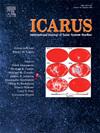A numerical model for the atmospheric entry of hydrated, phyllosilicate-rich micrometeorites
IF 3
2区 物理与天体物理
Q2 ASTRONOMY & ASTROPHYSICS
引用次数: 0
Abstract
Numerical modelling is crucial for understanding micrometeorite atmospheric entry, yet most existing models treat cosmic dust grains as chemically inert, anhydrous particles. In contrast, empirical studies of micrometeorites recovered on Earth reveal that hydrated, phyllosilicate-bearing particles, similar to the fine-grained matrix of carbonaceous chondrites, dominate the cosmic dust flux at size fractions above ∼100 μm. The thermal decomposition of phyllosilicates is expected to play a significant but currently unmodelled role in reducing peak temperatures during entry, thereby increasing the likelihood of their survival to the Earth's surface. To address this, we developed the first numerical model simulating the thermal response of phyllosilicate-dominated micrometeorites during atmospheric entry. Building on the Love and Brownlee (1991, Icarus, 89:26-43) model, we incorporate both sub-solidus decomposition and supra-solidus evaporation processes, as constrained by thermogravimetric analysis data from heating experiments on cronstedtite and saponite, reflecting the main phyllosilicate species found in CM, CR and CI chondrites. Three factors are crucial in determining the decomposition behaviour of phyllosilicate-dominated micrometeorites during entry: (1) grain density (d), (2) enthalpy of dehydration (Q), and (3) the volatile budget (max). Of these, density is the most influential. The sub-solidus loss of water helps reduce peak temperatures in phyllosilicate micrometeorites, but the effect, compared to anhydrous olivine, is modest (<35 °C for cronstedtite and <100 °C for saponite, on average). Furthermore, on average, saponite experiences peak temperatures that are 76 °C lower than those of cronstedtite. This is despite cronstedtite having a higher enthalpy of decomposition and a larger volatile budget. This effect is attributed to cronstedtite's higher density, which leads to more intense thermal processing, creating thermal histories similar to olivine-dominated micrometeorites. Since CI chondrites contain saponite, CI-like micrometeorites are more likely to survive entry without melting compared to CM-like micrometeorites under the same conditions. Finally, our results suggest that hydrated micrometeorites >50 μm are likely to survive atmospheric entry without loss of water only in grazing scenarios (entry angles >80°, where entry angle is measured from zero with respect to the zenith), this accounts for the rarity of hydrated fine-grained micrometeorites that contain intact crystalline phyllosilicates, as reported from petrographic studies of unmelted cosmic dust.
富含层状硅酸盐的水合微陨石进入大气的数值模型
数值模拟对于理解微陨石进入大气至关重要,但大多数现有模型将宇宙尘埃颗粒视为化学惰性的无水颗粒。相比之下,在地球上回收的微陨石的经验研究表明,水合的、含层状硅酸盐的颗粒,类似于碳质球粒陨石的细粒基质,在~ 100 μm以上的宇宙尘埃通量中占主导地位。层状硅酸盐的热分解预计将在降低进入时的峰值温度方面发挥重要作用,但目前尚未建立模型,从而增加它们在地球表面存活的可能性。为了解决这个问题,我们开发了第一个模拟层状硅酸盐为主的微陨石在进入大气时的热响应的数值模型。在Love和Brownlee (1991, Icarus, 89:26-43)模型的基础上,我们结合了亚固相分解和超固相蒸发过程,并结合了从长角辉石和皂土加热实验中获得的热重分析数据,反映了CM、CR和CI球粒陨石中发现的主要层状硅酸盐物种。三个因素对于确定层状硅酸盐为主的微陨石在进入过程中的分解行为至关重要:(1)颗粒密度(d),(2)脱水焓(Q)和(3)挥发收支(ζmax)。其中,密度是最具影响力的。水的亚固体损失有助于降低层状硅酸盐微陨石的峰值温度,但与无水橄榄石相比,这种效果是适度的(长角辉石平均为35°C,皂土平均为100°C)。此外,皂石的峰值温度平均比长角辉石低76℃。尽管克朗斯泰德有更高的分解焓和更大的挥发性预算。这种影响是由于长角铁辉石的密度较高,这导致了更强烈的热处理,产生了类似于橄榄石为主的微陨石的热历史。由于CI球粒陨石含有皂石,在相同条件下,CI类微陨石比cm类微陨石更容易在进入后不熔化。最后,我们的研究结果表明,水合微陨石>;50 μm只有在放牧情况下(进入角>;80°,进入角相对于天顶从零开始测量)才有可能在进入大气层时不损失水分,这解释了水合细粒微陨石的罕见性,这些微陨石含有完整的结晶层状硅酸盐,这是未融化宇宙尘埃的岩石学研究报告的结果。
本文章由计算机程序翻译,如有差异,请以英文原文为准。
求助全文
约1分钟内获得全文
求助全文
来源期刊

Icarus
地学天文-天文与天体物理
CiteScore
6.30
自引率
18.80%
发文量
356
审稿时长
2-4 weeks
期刊介绍:
Icarus is devoted to the publication of original contributions in the field of Solar System studies. Manuscripts reporting the results of new research - observational, experimental, or theoretical - concerning the astronomy, geology, meteorology, physics, chemistry, biology, and other scientific aspects of our Solar System or extrasolar systems are welcome. The journal generally does not publish papers devoted exclusively to the Sun, the Earth, celestial mechanics, meteoritics, or astrophysics. Icarus does not publish papers that provide "improved" versions of Bode''s law, or other numerical relations, without a sound physical basis. Icarus does not publish meeting announcements or general notices. Reviews, historical papers, and manuscripts describing spacecraft instrumentation may be considered, but only with prior approval of the editor. An entire issue of the journal is occasionally devoted to a single subject, usually arising from a conference on the same topic. The language of publication is English. American or British usage is accepted, but not a mixture of these.
 求助内容:
求助内容: 应助结果提醒方式:
应助结果提醒方式:


